Junjing Deng
Ptychographic Image Reconstruction from Limited Data via Score-Based Diffusion Models with Physics-Guidance
Feb 26, 2025



Abstract:Ptychography is a computational imaging technique that achieves high spatial resolution over large fields of view. It involves scanning a coherent beam across overlapping regions and recording diffraction patterns. Conventional reconstruction algorithms require substantial overlap, increasing data volume and experimental time. We propose a reconstruction method employing a physics-guided score-based diffusion model. Our approach trains a diffusion model on representative object images to learn an object distribution prior. During reconstruction, we modify the reverse diffusion process to enforce data consistency, guiding reverse diffusion toward a physically plausible solution. This method requires a single pretraining phase, allowing it to generalize across varying scan overlap ratios and positions. Our results demonstrate that the proposed method achieves high-fidelity reconstructions with only a 20% overlap, while the widely employed rPIE method requires a 62% overlap to achieve similar accuracy. This represents a significant reduction in data requirements, offering an alternative to conventional techniques.
Integrating Generative and Physics-Based Models for Ptychographic Imaging with Uncertainty Quantification
Dec 14, 2024Abstract:Ptychography is a scanning coherent diffractive imaging technique that enables imaging nanometer-scale features in extended samples. One main challenge is that widely used iterative image reconstruction methods often require significant amount of overlap between adjacent scan locations, leading to large data volumes and prolonged acquisition times. To address this key limitation, this paper proposes a Bayesian inversion method for ptychography that performs effectively even with less overlap between neighboring scan locations. Furthermore, the proposed method can quantify the inherent uncertainty on the ptychographic object, which is created by the ill-posed nature of the ptychographic inverse problem. At a high level, the proposed method first utilizes a deep generative model to learn the prior distribution of the object and then generates samples from the posterior distribution of the object by using a Markov Chain Monte Carlo algorithm. Our results from simulated ptychography experiments show that the proposed framework can consistently outperform a widely used iterative reconstruction algorithm in cases of reduced overlap. Moreover, the proposed framework can provide uncertainty estimates that closely correlate with the true error, which is not available in practice. The project website is available here.
Predicting ptychography probe positions using single-shot phase retrieval neural network
May 31, 2024Abstract:Ptychography is a powerful imaging technique that is used in a variety of fields, including materials science, biology, and nanotechnology. However, the accuracy of the reconstructed ptychography image is highly dependent on the accuracy of the recorded probe positions which often contain errors. These errors are typically corrected jointly with phase retrieval through numerical optimization approaches. When the error accumulates along the scan path or when the error magnitude is large, these approaches may not converge with satisfactory result. We propose a fundamentally new approach for ptychography probe position prediction for data with large position errors, where a neural network is used to make single-shot phase retrieval on individual diffraction patterns, yielding the object image at each scan point. The pairwise offsets among these images are then found using a robust image registration method, and the results are combined to yield the complete scan path by constructing and solving a linear equation. We show that our method can achieve good position prediction accuracy for data with large and accumulating errors on the order of $10^2$ pixels, a magnitude that often makes optimization-based algorithms fail to converge. For ptychography instruments without sophisticated position control equipment such as interferometers, our method is of significant practical potential.
Attentional Ptycho-Tomography (APT) for three-dimensional nanoscale X-ray imaging with minimal data acquisition and computation time
Nov 29, 2022Abstract:Noninvasive X-ray imaging of nanoscale three-dimensional objects, e.g. integrated circuits (ICs), generally requires two types of scanning: ptychographic, which is translational and returns estimates of complex electromagnetic field through ICs; and tomographic scanning, which collects complex field projections from multiple angles. Here, we present Attentional Ptycho-Tomography (APT), an approach trained to provide accurate reconstructions of ICs despite incomplete measurements, using a dramatically reduced amount of angular scanning. Training process includes regularizing priors based on typical IC patterns and the physics of X-ray propagation. We demonstrate that APT with 12-time reduced angles achieves fidelity comparable to the gold standard with the original set of angles. With the same set of reduced angles, APT also outperforms baseline reconstruction methods. In our experiments, APT achieves 108-time aggregate reduction in data acquisition and computation without compromising quality. We expect our physics-assisted machine learning framework could also be applied to other branches of nanoscale imaging.
Physics-Inspired Unsupervised Classification for Region of Interest in X-Ray Ptychography
Jun 29, 2022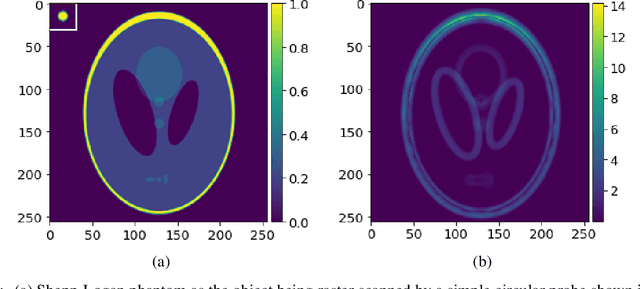

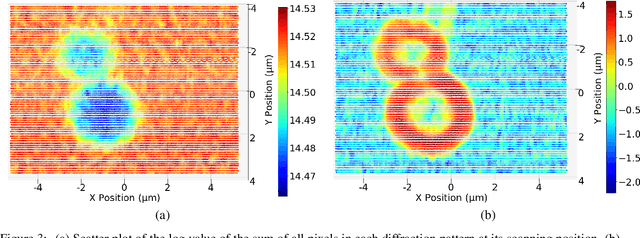
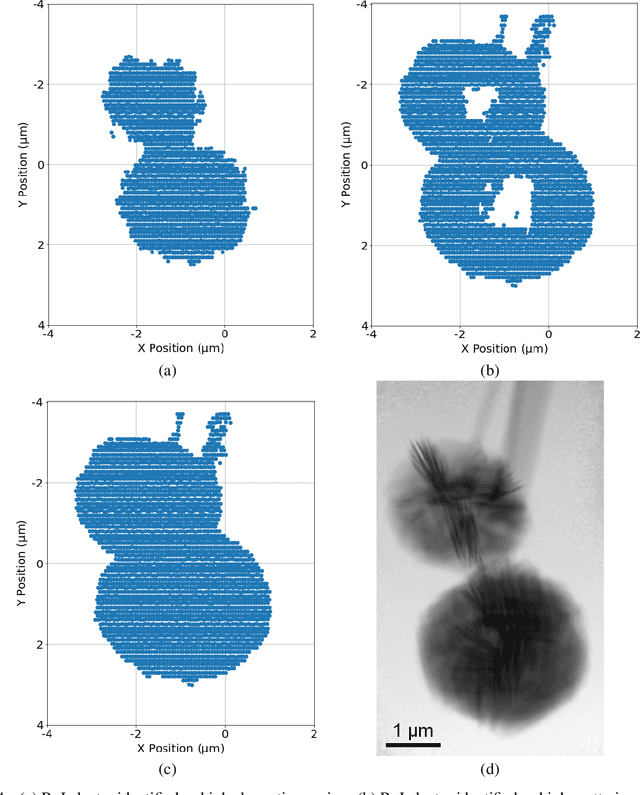
Abstract:X-ray ptychography allows for large fields to be imaged at high resolution at the cost of additional computational expense due to the large volume of data. Given limited information regarding the object, the acquired data often has an excessive amount of information that is outside the region of interest (RoI). In this work we propose a physics-inspired unsupervised learning algorithm to identify the RoI of an object using only diffraction patterns from a ptychography dataset before committing computational resources to reconstruction. Obtained diffraction patterns that are automatically identified as not within the RoI are filtered out, allowing efficient reconstruction by focusing only on important data within the RoI while preserving image quality.
Ptychopy: GPU framework for ptychographic data analysis
Jan 24, 2022Abstract:X-ray ptychography imaging at synchrotron facilities like the Advanced Photon Source (APS) involves controlling instrument hardwares to collect a set of diffraction patterns from overlapping coherent illumination spots on extended samples, managing data storage, reconstructing ptychographic images from acquired diffraction patterns, and providing the visualization of results and feedback. In addition to the complicated workflow, ptychography instrument could produce up to several TB's of data per second that is needed to be processed in real time. This brings up the need to develop a high performance, robust and user friendly processing software package for ptychographic data analysis. In this paper we present a software framework which provides functionality of visualization, work flow control, and data reconstruction. To accelerate the computation and large datasets process, the data reconstruction part is implemented with three algorithms, ePIE, DM and LSQML using CUDA-C on GPU.
Adorym: A multi-platform generic x-ray image reconstruction framework based on automatic differentiation
Dec 22, 2020
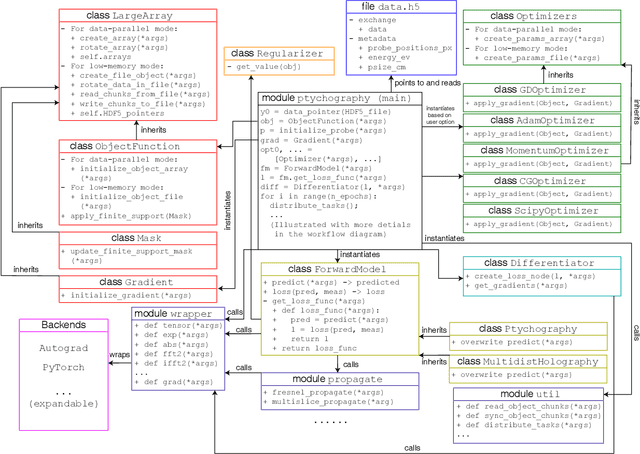
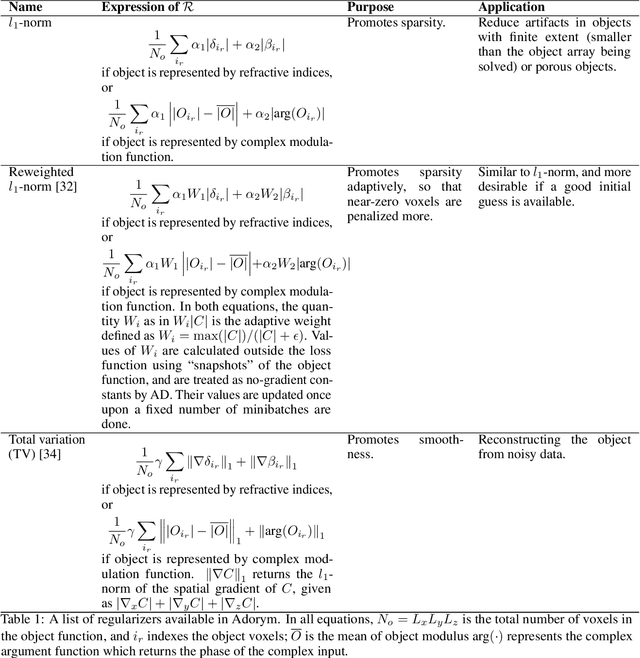
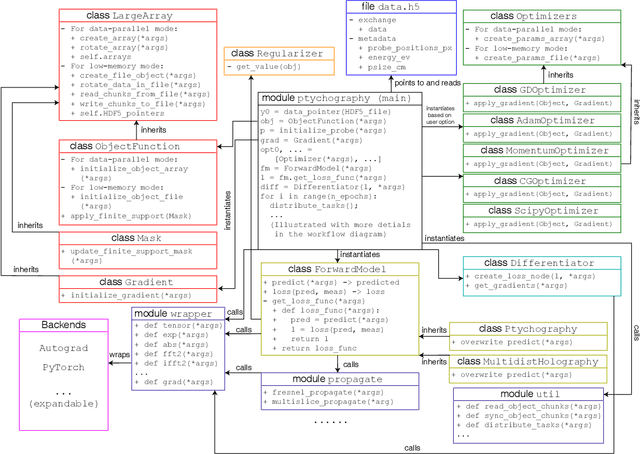
Abstract:We describe and demonstrate an optimization-based x-ray image reconstruction framework called Adorym. Our framework provides a generic forward model, allowing one code framework to be used for a wide range of imaging methods ranging from near-field holography to and fly-scan ptychographic tomography. By using automatic differentiation for optimization, Adorym has the flexibility to refine experimental parameters including probe positions, multiple hologram alignment, and object tilts. It is written with strong support for parallel processing, allowing large datasets to be processed on high-performance computing systems. We demonstrate its use on several experimental datasets to show improved image quality through parameter refinement.
 Add to Chrome
Add to Chrome Add to Firefox
Add to Firefox Add to Edge
Add to Edge